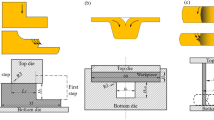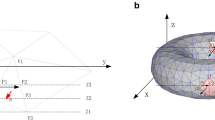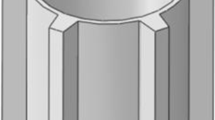Abstract
A high percentage of folding defects were more easily introduced into the outer area of the sleeve hole during the mass production of track link forgings. In this study, it could be found that the folding defects were induced by the end-surface quality of the billet with the streamline characterization and the points tracking simulation. A defect elimination method based on the preforming design was proposed according to the numerical simulation and the experiment. The outer wall of the sleeve hole in the die cavity was shrunk inwards a certain distance to extrude the surface defects of the billet into the flash during the pre-forging. And then, the original flat shape punching wad of the sleeve hole was designed as an oblate-frustum of a cone shape to compensate the shortage of the material volume. The shrinkage range and the justified height of the oblate-frustum preform were recommended by the numerical simulation. As a result, the experiments showed that the proposed preforming design method completely eliminated the folding defects of the track link forgings.




















Similar content being viewed by others
References
Mondal, M., Basak, S., Das, H., Hong, S. T., Choi, H., Park, J. W., & Han, H. N. (2021). Manufacturing of magnesium/aluminum bimetallic ring components by friction stir assisted simultaneous forging and solid-state joining. International Journal of Precision Engineering and Manufacturing-Green Technology, 8, 1429–1438. https://doi.org/10.1007/s40684-020-00244-0
Kwon, I. K., & Park, H. S. (2011). Design of die forging process of thrust shaft for large marine diesel engine using floating die concept. International Journal of Precision Engineering and Manufacturing, 12, 527–535. https://doi.org/10.1007/s12541-011-0066-z
Park, D. H., & Kwon, H. H. (2016). Development of automobile engine mounting parts using hot-cold complex forging technology. International Journal of Precision Engineering and Manufacturing-Green Technology, 3, 179–184. https://doi.org/10.1007/s40684-016-0023-5
Rajiev, R., Sadagopan, P., & Shanmuga Prakash, S. (2020). Study on investigation of hot forging die wear analysis—An industrial case study. Materials Today: Proceedings, 27, 2752–2757. https://doi.org/10.1016/j.matpr.2019.11.330
Behrens, B. A., Volk, W., Maier, D., Scandola, L., Ott, M., Brunotte, K., Büdenbender, C., & Till, M. (2020). A combined numerical and experimental investigation on deterministic deviations in hot forging processes. Procedia Manufacturing, 47, 295–300. https://doi.org/10.1016/j.promfg.2020.04.231
Gronostajski, Z., Pater, Z., Madej, L., Gontarz, A., Lisiecki, L., Łukaszek Sołek, A., Łuksza, J., Mróz, S., Muskalski, Z., Muzykiewicz, W., Pietrzyk, M., Śliwa, R. E., Tomczak, J., Wiewiórowska, S., Winiarski, G., Zasadziński, J., & Ziółkiewicz, S. (2019). Recent development trends in metal forming. Archives of Civil and Mechanical Engineering, 19, 898–941. https://doi.org/10.1016/j.acme.2019.04.005
Zhang, Y. Q., Jiang, S. Y., Zhao, Y. N., & Shan, D. B. (2014). Isothermal precision forging of aluminum alloy ring seats with different preforms using FEM and experimental investigation. The International Journal of Advanced Manufacturing Technology, 72, 1693–1703. https://doi.org/10.1007/s00170-014-5784-9
Chan, W. L., Fu, M. W., Lu, J., & Chan, L. C. (2009). Simulation-enabled study of folding defect formation and avoidance in axisymmetrical flanged components. Journal of Materials Processing Technology, 209, 5077–5086. https://doi.org/10.1016/j.jmatprotec.2009.02.005
Song, J. H., & Im, Y. T. (2007). Process design for closed-die forging of bevel gear by finite element analyses. Journal of Materials Processing Technology, 192–193, 1–7. https://doi.org/10.1016/j.jmatprotec.2007.04.081
Kim, H. H., & Kang, C. G. (2010). Numerical simulation and experimental study for rheo-forged component using direct and indirect die system. Transactions of Nonferrous Metals Society of China, 20, 1799–1804. https://doi.org/10.1016/S1003-6326(09)60377-0
Wei, K., Zhan, M., Fan, X. G., Yang, H., Gao, P. F., & Meng, M. (2018). Unequal-thickness billet optimization in transitional region during isothermal local loading forming of Ti-alloy rib-web component using response surface method. Chinese Journal of Aeronautics, 31, 845–859. https://doi.org/10.1016/j.cja.2017.07.005
Gao, P. F., Fan, X. G., Zhan, M., Lei, Z. N., & Cai, Y. (2017). Formation mechanism, prediction and control of the forming defects in transitional region during local loading forming of Ti-alloy rib-web component. Procedia Engineering, 207, 472–477. https://doi.org/10.1016/j.cja.2017.07.005
Guan, Y. J., Bai, X., Liu, M. J., Song, L. B., & Zhao, G. Q. (2015). Preform design in forging process of complex parts by using quasi-equipotential field and response surface methods. The International Journal of Advanced Manufacturing Technology, 79, 21–29. https://doi.org/10.1007/s00170-014-6775-6
Gao, P. F., Fei, M. Y., Yan, X. G., Wang, S. B., Li, Y. K., Xing, L., Wei, K., Zhan, M., Zhou, Z. T., & Keyim, Z. (2019). Prediction of the folding defect in die forging: A versatile approach for three typical types of folding defects. Journal of Manufacturing Processes, 39, 181–191. https://doi.org/10.1016/j.jmapro.2019.02.027
Abdullah, A. B., Sapuan, S. M., Samad, Z., Khaleed, H. M. T., & Aziz, N. A. (2013). Numerical investigation of geometrical defect in cold forging of an AUV blade pin head. Journal of Manufacturing Processes, 15, 141–150. https://doi.org/10.1016/j.jmapro.2012.11.003
Zhao, G. Q., Wang, G. C., & Grandhi, R. V. (2002). Die cavity design of near flashless forging process using FEM-based backward simulation. Journal of Materials Processing Technology, 121, 173–181. https://doi.org/10.1016/S0924-0136(01)00998-0
Park, H. S., Nguyen, T. T., & Dang, X. P. (2016). Energy-efficient optimization of forging process considering the manufacturing history. International Journal of Precision Engineering and Manufacturing-Green Technology, 3, 147–154. https://doi.org/10.1007/s40684-016-0018-2
Cha, D. J., Kim, D. K., Cho, J. R., & Bae, W. B. (2011). Hot shape forging of gas turbine disk using microstructure prediction and finite element analysis. International Journal of Precision Engineering and Manufacturing, 12, 331–336. https://doi.org/10.1007/s12541-011-0043-6
Hawryluk, M., & Jakubik, J. (2016). Analysis of forging defects for selected industrial die forging processes. Engineering Failure Analysis, 59, 396–409. https://doi.org/10.1016/j.engfailanal.2015.11.008
Hawryluk, M. (2016). Review of selected methods of increasing the life of forging tools in hot die forging processes. Archives of Civil and Mechanical Engineering, 16, 845–866. https://doi.org/10.1016/j.acme.2016.06.001
Ishikawa, T., Yukawa, N., Yoshida, Y., & Tozawa, Y. (2005). Analytical approach to elimination of surface micro-defects in forging. CIRP Annals, 54, 249–252. https://doi.org/10.1016/S0007-8506(07)60095-X
Acknowledgements
This work was supported by the Major Innovation Project of Shandong Province, China (grant number 2019JZZY010431) and the Science and Technology Special Project of Rizhao, Shandong Province of China (grant number 2020CXZX1207).
Author information
Authors and Affiliations
Corresponding author
Ethics declarations
Competing interests
The authors declare no competing interests.
Additional information
Publisher's Note
Springer Nature remains neutral with regard to jurisdictional claims in published maps and institutional affiliations.
Rights and permissions
Springer Nature or its licensor holds exclusive rights to this article under a publishing agreement with the author(s) or other rightsholder(s); author self-archiving of the accepted manuscript version of this article is solely governed by the terms of such publishing agreement and applicable law.
About this article
Cite this article
Ge, X., Yu, Y., Yu, H. et al. Study on Folding Defect Elimination Method of Track Link Forging Based on Preforming Design. Int. J. Precis. Eng. Manuf. 24, 61–71 (2023). https://doi.org/10.1007/s12541-022-00725-z
Received:
Revised:
Accepted:
Published:
Issue Date:
DOI: https://doi.org/10.1007/s12541-022-00725-z




